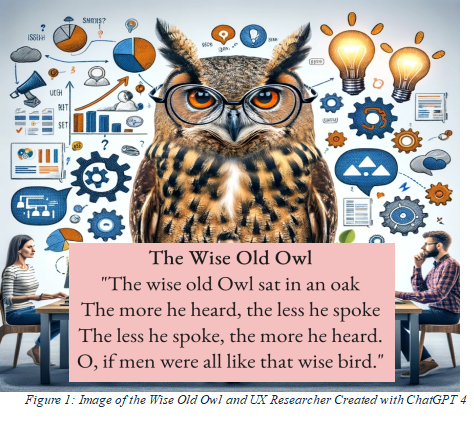
- Introduction
User Experience (UX) research is a field that thrives on deep insights, empathy, and meticulous observation. Drawing parallels between the characteristics of a wise old owl and the essential skills of a UX researcher can offer unique perspectives and practical lessons for anyone involved in user experience design. The “Wise Old Owl” (see the poem in the figure above) is a classic Poem that beautifully encapsulates these ideas, blending the wisdom of an owl with the critical traits and practices of effective UX research. This classic poem serves as a simple yet profound reminder of the value of listening and observation. The owl, a symbol of wisdom, teaches us that silence and attentiveness can lead to deeper understanding and more insightful conclusions.
- Characteristics of the Owl
Owls are renowned for their acute hearing, keen vision, and masterful observation skills. These traits make them exceptional hunters, capable of precisely locating their prey even in the dark. Key characteristics include:
- Astute Listener: Owls are known for their exceptional listening skills, which enable them to hear even the faintest sounds.
- Master Observer: Their ability to observe their surroundings with minimal movement makes them stealthy and efficient.
- Keen Vision: Owls have remarkable visual acuity, allowing them to see clearly in low-light conditions.
- Visual Acuity: Their eyes are specially adapted to detect the slightest movements, which is critical for hunting.
- Private and Secretive: Owls tend to be solitary and secretive, avoiding unnecessary exposure.
- Acute Hearing: They have highly sensitive hearing, capable of picking up the faintest of noises.
- Instinctive: Owls rely on their instincts to navigate and hunt.
- Flexible: Their flexible necks allow them to have a wide range of vision without moving their bodies.
- Precision: Owls can precisely locate their prey, showcasing their extraordinary sensory capabilities.

- Critical Lessons for UX Researchers
UX researchers can draw several lessons from the owl’s characteristics to enhance their practice:
- Listen Deeply
- Like the owl, UX researchers must prioritize listening while conducting research. This involves not just hearing but truly understanding the user’s needs, pain points, and experiences.
- Critical Lesson: The more we listen, the less we assume, leading to more accurate and user-centered designs.
- Observe with Empathy
- Empathizing with users involves observing their behavior and interactions without bias. This helps in understanding the user’s environment and context better.
- Critical Lesson: Empathetic observation allows researchers to gain deeper insights into user behavior and needs.
- Precision in Analysis
- Just as owls can precisely locate sounds, UX researchers need to be precise in their analysis of user data. This means carefully sifting through qualitative and quantitative data to extract meaningful insights.
- Critical Lesson: Precision in analysis leads to more actionable insights and effective design solutions.
- Use Keen Vision for Detail
- Paying attention to details is crucial in UX research. Small nuances in user behavior or feedback can lead to significant improvements in design.
- Critical Lesson: Keen observation helps in identifying subtle, yet impactful user needs and preferences.
- Flexibility and Adaptability
- Owls are flexible and adaptable, traits that are equally important for UX researchers. Adapting research methods and approaches based on the project’s needs and user feedback is vital for success.
- Critical Lesson: Flexibility allows researchers to respond to changing requirements and discover new opportunities.
- Maintain Confidentiality and Security
- Owls are private and secretive, traits that remind UX researchers of the importance of maintaining user confidentiality and data security.
- Critical Lesson: Ensuring privacy and security builds user trust and ethical research practices.
- Instinctive Decision Making
- Leveraging intuition and experience in making quick decisions during research can be beneficial, much like how owls rely on their instincts.
- Critical Lesson: Instinctive decision-making, when combined with data, leads to more effective research outcomes.
- Enhancing User Empathy
- The more researchers hear and empathize with users, the better they can design solutions that truly meet user needs.
- Critical Lesson: Deep empathy fosters user-centric designs and enhances overall user satisfaction.
In conclusion, the wisdom of the owl offers valuable lessons for UX researchers. By adopting traits such as deep listening, precise analysis, and empathetic observation, researchers can enhance their effectiveness and deliver more impactful user experiences. The integration of these lessons into daily practice can transform how UX researchers understand and address user needs, leading to more intuitive and user-friendly designs.
References: